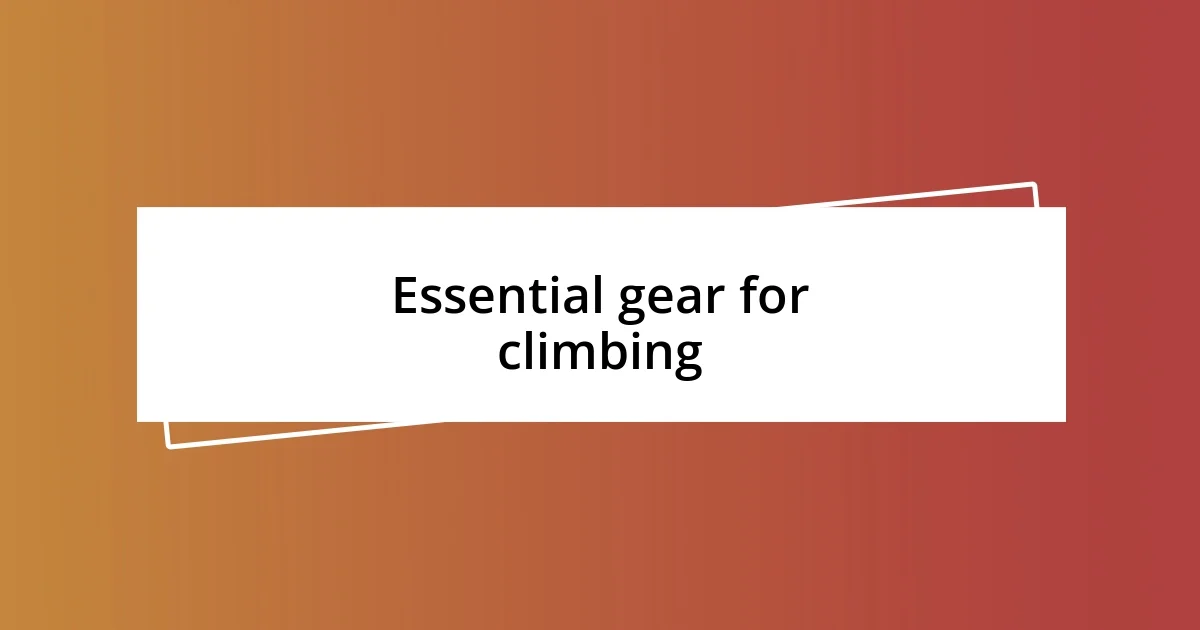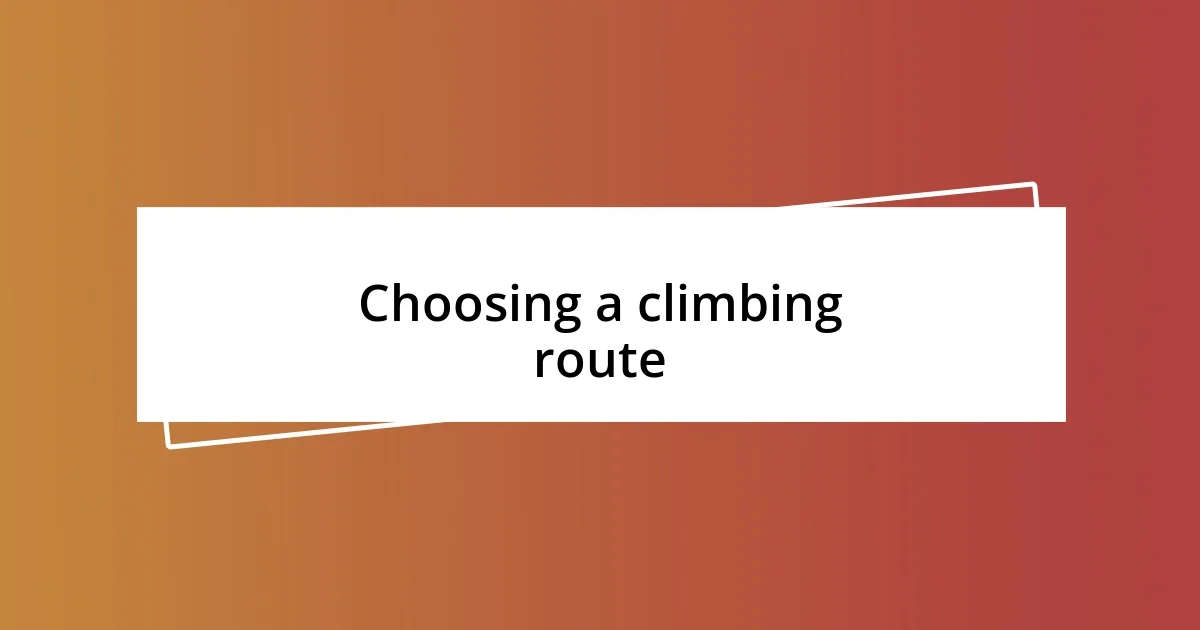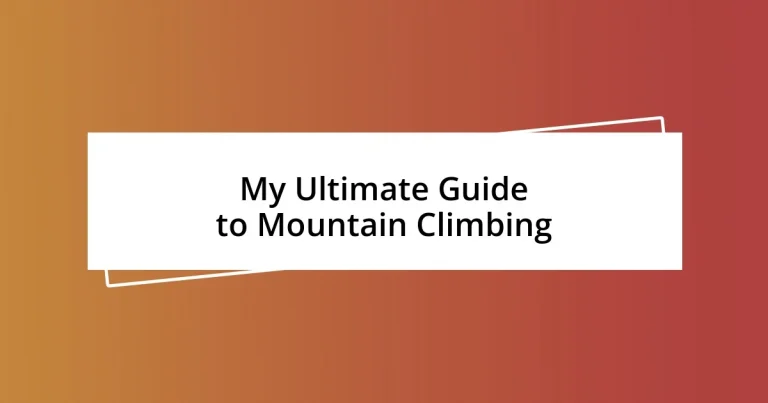Key takeaways:
- Mountain climbing is a journey that tests physical and mental limits; understanding local stories enhances the experience.
- Having essential gear is critical for safety and performance, including items like harnesses, helmets, and first aid kits.
- Preparation, including mental visualization, physical training, and effective communication with partners, is key to a successful climb.

Understanding mountain climbing
Mountain climbing is not just about reaching the summit; it’s a journey that tests both your physical and mental limits. I remember the first time I faced a steep, rocky incline; my heart raced with a mix of fear and exhilaration. Doesn’t that feeling of being on the edge, teetering between challenge and triumph, resonate with anyone who’s pushed their limits?
Each mountain holds its own story and tradition, and I’ve found that understanding these elements deepens the experience. For instance, during a trek in the Alps, I learned local legends from fellow climbers, which enhanced my appreciation of the majestic views. Doesn’t it add a layer of richness when you connect emotionally with your surroundings, understanding the history and culture that shaped them?
Moreover, preparing for a climb encompasses much more than packing gear; it’s about respecting nature and your own capabilities. I still recall a moment when I underestimated a hike, realizing halfway that I needed to listen to my body and pace myself better. Isn’t it fascinating how mountains can teach us humility and resilience, reminding us to cherish every step we take?

Essential gear for climbing
When it comes to mountain climbing, having the right gear is critical for both safety and performance. I still vividly remember my first multi-day climb, where every ounce of equipment counted. Packing the essentials made me realize that the right tools not only support my ascent but also enhance the overall experience, allowing me to focus on the climb itself rather than worrying about what I might be missing.
Here’s a list of essential gear every climber should consider:
- Climbing harness: A must-have for safety, it allows you to stay secure while climbing.
- Climbing shoes: Proper footwear enhances grip and stability on challenging terrains.
- Helmet: Protects your head from falling debris, an essential piece of safety equipment.
- Carabiners: Useful for securing yourself and your gear; I still recall the time I dropped one and learned the hard way how critical spare gear is!
- Ropes: Vital for climbing and rappelling, the right rope can make all the difference in a tricky situation.
- First aid kit: Accidents happen; being prepared helps you tackle unexpected moments without panic.
- Layered clothing: Weather can change quickly; I learned that having both moisture-wicking and insulation layers kept me comfortable in shifting conditions.
Ensuring you have the right gear can dramatically affect your climbing experience. Each piece plays a role in your journey, helping you connect more deeply with both the task at hand and the stunning environments you’re traversing.

Choosing a climbing route
Choosing the right climbing route is crucial to having a rewarding experience. I remember being at a trailhead, peering at the map and feeling the weight of my choice. Should I opt for that scenic but challenging path or a more straightforward ascent? It’s vital to assess your skill level, the difficulty of routes, and, importantly, the current weather conditions. Reflecting on my early climbs, I can say that a wise decision at this stage can make or break your adventure.
In my experience, researching the climbing routes beforehand can save a world of trouble. I’ve often navigated online forums and local climbing groups to get real-time feedback. There’s something reassuring about hearing from others who have trekked that same path. It’s akin to having a conversation with someone who’s been there—it adds a comfort that’s hard to quantify. When selecting a route, I always weigh in factors such as the type of climb (trad, sport, or mixed), the elevation gain, and potential hazards. After all, understanding what lies ahead lets me mentally prepare for the physical demands.
Lastly, don’t forget to consider the environment. Each trail has its unique challenges and beauty. One time, I took a popular route through a breathtaking valley, only to realize that the terrain was much more technical than advertised. Learning to balance the allure of scenic beauty with safety is part of the process. Have you ever found yourself drawn to a beautiful path only to be tested by its difficulties? It’s in those moments that I’ve discovered the depth of my own resilience and adaptability.
| Route Type | Skill Level Required |
|---|---|
| Beginner | Easy to Moderate |
| Intermediate | Moderate to Hard |
| Advanced | Hard to Extremely Hard |

Tips for climbing preparation
Preparation for climbing can set the foundation for a successful adventure. One lesson I’ve learned is the importance of mental preparation. Before my first major ascent, I spent quiet evenings visualizing each step—how I would handle tricky sections and the emotions I would feel standing at the summit. This kind of mental rehearsal helped me build confidence and visualize overcoming obstacles, making the actual climb feel a bit less daunting.
Physical training is equally important. In the months leading up to a significant climb, I focused on cardio and strength exercises tailored to climbing. I remember pushing myself through long hikes with a weighted backpack, feeling my muscles burn but also my determination grow. Those moments reinforced my belief that a fit body translates into a climbing performance that’s both safe and enjoyable. Are you ready to invest that kind of effort into your preparation?
Lastly, don’t underestimate the power of a solid plan. I’ve found it invaluable to break down the climb into manageable segments, outlining not just my route but also setting checkpoints for rest and hydration. On one occasion, I miscalculated my water supply on a particularly hot day, and trust me, that was a learning experience! By planning ahead, I’ve been able to avoid unnecessary hardships and truly savor the experience while maintaining a steady pace. What strategies do you have in place for your own climbing preparation?

Basic climbing techniques
When it comes to basic climbing techniques, mastering your footwork can make a world of difference. I remember the thrill when I finally understood how to distribute my weight and balance on small footholds. It’s like a dance, each step must be precise and deliberate. Have you ever found yourself slipping because you were too focused on the next handhold? I certainly have, and those moments taught me the significance of trusting my feet and staying poised.
Another essential technique is learning how to use your hands effectively. Grip can vary immensely depending on the surface—sometimes you’ll encounter crimps that require delicate strength, while other times, you might use your whole hand on larger holds. I once spent an afternoon bouldering, figuring out the difference between an open-handed grip and a crimp. The way my fingers felt after each climb was a reminder of how vital it is to adapt my approach based on the rock’s texture. It’s a lesson worth remembering: your hands can be your allies if you know how to use them.
Lastly, body positioning and movement efficiency play significant roles in climbing success. I recall a challenging climb where I had to navigate a series of overhangs, and I found that pushing my hips closer to the wall not only stabilized me but also made it easier to reach the next hold. This experience highlighted a key principle: conserving energy is crucial. Do you feel exhausted after every climb? By focusing on how your body moves as a cohesive unit, I assure you, you’ll discover less fatigue and more enjoyment in every ascent.

Safety measures in climbing
Safety measures in climbing are non-negotiable. I still remember a time when I neglected to double-check my harness, thinking it was secure. About halfway up the route, I felt a nagging doubt creeping in. Fortunately, I made it to a ledge where I could pause and reevaluate my gear. That moment taught me the invaluable lesson: always prioritize checking your equipment before starting your climb. What about you? Do you have a routine to ensure your gear is up to par?
In addition to equipment checks, communications with your climbing partners are key. One unforgettable excursion with friends turned into a scramble when we didn’t discuss the plan ahead of time. Halfway up, we realized we were not on the same page regarding our descent strategy. As we navigated down, I felt a mix of anxiety and camaraderie. That experience reinforced the importance of a clear communication plan—elements like agreeing on signals, coordinating rest breaks, and ensuring everyone is aware of the route can make or break your climbing experience.
Lastly, understanding weather conditions cannot be overstated for climbing safety. I once set out on a beautiful morning, only to be caught in an unexpected storm. The transformation from clear skies to pouring rain left me feeling anxious and exposed. It underscored the reality of nature’s unpredictability. Now, I always check forecasts before a climb and stay prepared for sudden changes. Have you considered the weather’s impact on your climbing plans? Being aware can mean the difference between a thrilling adventure and a perilous situation.

Resources for continuous learning
I’ve found that continuous learning in mountain climbing is essential, and there are so many fantastic resources out there. For instance, I often turn to online climbing courses and video tutorials that break down various techniques in a visual format. It’s almost like having a mentor in your pocket! Have you ever tried watching instructional videos? They can really enhance your understanding and make complex skills feel more achievable.
Books focused on climbing can also deepen your knowledge. I still remember curling up with “Mountaineering: The Freedom of the Hills” on a rainy afternoon, becoming engrossed in its pages. The wealth of information regarding gear, safety procedures, and climbing techniques was overwhelming yet invigorating. Each chapter taught me something new—from the importance of knots to nutrition on long climbs. Have you discovered any climbing literature that’s inspired you?
Finally, I’ve been fortunate to participate in local climbing workshops and community meetups. These events are surprisingly valuable, as they offer hands-on experience and the chance to learn from others’ journeys. I recall an evening workshop where we practiced setting up anchors and discussing techniques in small groups. The shared knowledge was like a breath of fresh air—have you ever felt that sense of community while learning? The support and camaraderie in those settings can really fuel your growth as a climber.














